|
|
|
Sort Order |
|
|
|
Items / Page
|
|
|
|
|
|
|
| Srl | Item |
| 1 |
ID:
132436
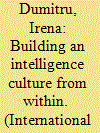

|
|
|
|
|
| Publication |
2014.
|
| Summary/Abstract |
Collective perceptions on intelligence services have been for centuries associated with a sense of mystery, obscurity, and clandestine behavior. At the same time, intelligence success could not be traditionally conceived and exercised in the absence of cover, duplicity, truth manipulation, and intentional avoidance, as well as of masks adapted to context. Therefore, intelligence would traditionally be based on secrecy and a mainly "no communication" approach. Thus, secrecy inherently marked intelligence, as both a barrier created from inside the organization towards the outside world and as a label placed by public opinion on the intelligence organization, therefore shaping knowledge of what cannot otherwise be known.
|
|
|
|
|
|
|
|
|
|
|
|
|
|
|
|
| 2 |
ID:
132418
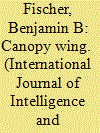

|
|
|
|
|
| Publication |
2014.
|
| Summary/Abstract |
Although Winston Churchill declared that history is always written by the victors, never the vanquished, a group of former East German foreign intelligence officers seem determined to prove him wrong. Calling themselves Insiders have been churning out books since the end of the Cold War that recount the history of that conflict from their perspective. The Insiders' mantra is that they were on the right, even if losing, side because they "spied for peace" to protect the Warsaw Pact against the existential threat posed by the "aggressive intentions" of the West.
|
|
|
|
|
|
|
|
|
|
|
|
|
|
|
|
| 3 |
ID:
132420
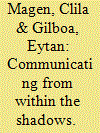

|
|
|
|
|
| Publication |
2014.
|
| Summary/Abstract |
Communicating with the media is an ongoing complicated task intelligence services tackle from the day they are established. The relationship is inherently tense because one side wishes to reveal what the other wishes to conceal, highlighting the constant contradiction between two major principles: the public's right to know versus the government's duty to protect national security. Reconciling these two principles becomes exceedingly complex during crisis situations because both the media and the public demand to know what is happening and why, whereas intelligence services can offer only limited and often incomplete information, a limitation imposed by the need to protect vital secrets. Moreover, the services frequently face a quandary: they are innately secretive and cannot advertise their accomplishments and successes, but these are commonly exposed when they fail. This distorts the natural balance other organizations are generally able to maintain between failures and achievements and any publicity about them.
|
|
|
|
|
|
|
|
|
|
|
|
|
|
|
|
| 4 |
ID:
132424
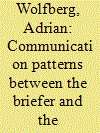

|
|
|
|
|
| Publication |
2014.
|
| Summary/Abstract |
Intelligence professionals called "briefers" provide intelligence information on a daily basis to senior civilian policymakers. Herein is a description of what actually takes place prior to, during, and after the face-to-face interaction. While a body of work exists on presidential briefings, this assessment is unique because it deals with the process of transferring knowledge to policymakers, and specifically from the briefer's perspective. Individuals from the outside, and even intelligence officers or others who have studied intelligence but have not been "briefers," might find some of this material fascinating, yet possibly hard to believe. But those who have been "briefers" will find that this mostly validates their experience."
|
|
|
|
|
|
|
|
|
|
|
|
|
|
|
|
| 5 |
ID:
132443
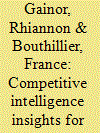

|
|
|
|
|
| Publication |
2014.
|
| Summary/Abstract |
For competitive and business intelligence, as for covert or military intelligence, the term "intelligence" connotes a combination of raw data, technology, and analysis resulting in intelligence deliverables such as reports and profiles. For all intelligence fields, the primary purpose of intelligence is to inform decisionmaking, with the intent of increasing the likelihood of the most optimal outcomes for the organization. 1 Competitive intelligence in the business sector is sometimes called by other labels, such as business or market intelligence. 2 It involves surveying and monitoring the competitive environment and developing intelligence to inform decisionmaking.
|
|
|
|
|
|
|
|
|
|
|
|
|
|
|
|
| 6 |
ID:
132419
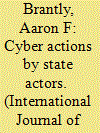

|
|
|
|
|
| Publication |
2014.
|
| Summary/Abstract |
Covert action is as old as political man. The subversive manipulation of others is nothing new. It has been written about since Sun Tzu and Kautilya. People and nations have always sought the use of shadowy means to influence situations and events. Covert action is and has been a staple of the state system. A dark and nefarious tool often banished to philosophical and intellectual exile, covert action is in truth an oft-used method of achieving utility that is frequently overlooked by academics. Modern scholars contend that, for utility to be achieved, activities such as war and diplomacy must be conducted transparently. Examined here is the construction of utility for a subset of covert action: cyber attacks.
|
|
|
|
|
|
|
|
|
|
|
|
|
|
|
|
| 7 |
ID:
132444
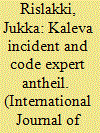

|
|
|
|
|
| Publication |
2014.
|
| Summary/Abstract |
An experienced U.S. code clerk was among the victims when the Soviets shot down a civilian Finnish passenger plane on a regular flight above the Baltic Sea in June 1940. It happened three months after the end of the Winter War between Soviet Union and Finland. Was the 27-year-old code expert Henry W. Antheil, and the diplomatic pouches and codes he was carrying, the reason for this attack?
Very belated, in May 2007, the name of Henry W. Antheil, Jr. was finally inscribed on a marble memorial plaque in the U.S. State Department's C Street lobby. 1 His career was cut tragically short on 14 June 1940, when his plane, the Finnish Aero airliner Junkers Ju 52 Kaleva was destroyed at 2:05 p.m. local time, shortly after taking off from Tallinn's Ülemiste airport en route to Helsinki.
|
|
|
|
|
|
|
|
|
|
|
|
|
|
|
|
| 8 |
ID:
132431
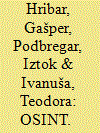

|
|
|
|
|
| Publication |
2014.
|
| Summary/Abstract |
Open Source Intelligence (OSINT) is generally seen in positive terms, particularly as a method of conventional intelligence collection that does not violate human rights. Of all the data collection methods, OSINT is, arguably, the only fully legal method. It can be conducted anytime, anywhere, and with any (legal) tools/software, as long as it does not violate human rights. In principle, however, OSINT does not and should not violate human rights, therefore such tools are all, again arguably, legal. Thus, its legality makes OSINT globally available, including to markets around the world. The free market offers various legal tools that facilitate the analytical procedures of data acquisition and analysis, and which no longer represent a major technical and logistical obstacle. Hypothetically, OSINT can be carried out by anyone with such specific tools and knowledge. These tools can be obtained by anyone free of charge or by paying for the licensed program, while the knowledge necessary to conduct OSINT is relatively easily acquired. Even though the tools and knowledge are freely accessible, the major difference between basic and excellent OSINT "operations" lies in the analytical process. Only experts with good analytical skills and knowledge manage to provide the right information at the right time to their customers/policymakers. OSINT is also a formal tool and means of analytical support in the work of intelligence services. Intelligence service analysts are capable of the advanced use of OSINT-they are familiar with specialized sources of specific data, advanced techniques of acquiring data, and the analytical steps needed for successful processing, exploitation, and analysis of massive amounts of data. The exploitation of special sources and the use of advanced techniques make OSINT questionable when seen through the prism of legality. The exploitation is at times semi-legal or even, arguably, illegal. The use of "special" techniques in OSINT can therefore lie on the edge between the legal and the illegal. These actions are sometimes clearly illegal, of course, and therefore forbidden by the criminal law; such practice by the intelligence services is not sanctioned. This raises the following questions: Could the intelligence services using OSINT in a legal manner to serve their specific individual interests interfere in another country on the ground of this same legality? Without this hypothetical "grey zone" would they be acting illegally and so become subject to counterintelligence observation?
|
|
|
|
|
|
|
|
|
|
|
|
|
|
|
|
| 9 |
ID:
132432


|
|
|
|
|
| Publication |
2014.
|
| Summary/Abstract |
Much of today's intelligence literature emphasizes the role of cognitive bias and organizational pathologies in the explanation of intelligence failure. Adversary deception complicates the problem, not only for intelligence analysts and managers but for intelligence theorists as well. Operation Bodyguard, the deception plan covering Allied landings in Normandy in northwestern France in June 1944, is a case in point. Although German intelligence and decisionmaking displayed flaws, Bodyguard was such a monumental and masterful counterintelligence and deception operation that even perfectly rational individuals and organizations might have struggled to divine the truth through its fog and misdirection. Much of its deceptive power derived from the exploitation of human psychological traits that have come to be understood scientifically only in recent decades.
Although a famous historical event (associated with one of World War II's most famous quotations), Bodyguard warrants re-examination in light of modern psychology and intelligence theory. This battle between intelligence and deception is valuable as a case study in the general theory of deception and its underlying cognitive factors, understanding and mastery of which are vital to success in information-age conflict.
|
|
|
|
|
|
|
|
|
|
|
|
|
|
|
|
|
|
|
|
|